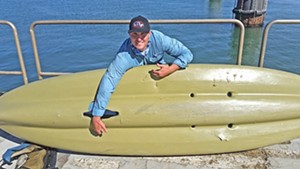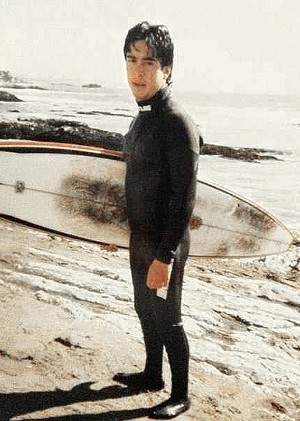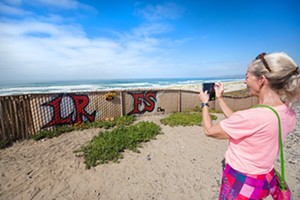It was hot, sunny, and the water was relatively calm when Ryan Howell and his friends took their kayaks out for a little rock fishing about 5 miles south of Surf Beach on Oct. 3, 2014. The fishing was good that day.
An avid kayak fisherman, Howell has fished the waters off the coast of Santa Barbara County for years and he’s familiar with the territory. As a 28-year-old firefighter for Cal Fire, getting put into dangerous situations is a regular part of his job. He’s generally aware of the dangers of the ocean and what lurks beneath, but he never suspected what was about to happen on that particular day.

Howell gave an account to the Sun of what happened next. He was sitting in his kayak when he was suddenly thrown into the water. One second Howell was sitting on his kayak with a fishing pole in his hand, the next second he was in the water fighting for his life. He was being attacked by a great white shark.
He fell to one side and the shark was on the other. All Howell saw was a huge mass of gray and teeth. The shark’s gaping, tooth-filled maw chomped down on the kayak, pushing it toward him. Howell believes that the kayak, which was pinned between him and the shark, was the only thing that saved his life.
“If I had landed on the other side of the kayak, it would have been game over,” Howell told the Sun. “Especially with how big they’re saying it is.”
Howell estimates the entire episode lasted 15 to 20 seconds. After the initial attack, the shark swam away and never came back. Not wanting to take his chances, Howell climbed on the back of his friend’s kayak and they radioed for help. Within five minutes, Howell was plucked off the kayak by a leisure boater who came to the rescue.
In his 10 years of kayak fishing, Howell had never previously come close to being attacked by a shark, he said.
Judging by the bite marks on the kayak, Howell said that researchers estimate that the shark had to be at least 20 feet in length—one of the largest great whites ever involved in an attack off the coast of California.
It wasn’t the first attack off Surf Beach that day, or in recent years. About an hour before he was attacked, Howell had witnessed another kayaker get knocked off his boat, presumably by the same shark. Howell and the unknown kayaker that day were fortunate in their encounters.
Just two years previous, in October 2012, 39-year-year old Francisco Solorio Jr. was attacked and killed while surfing near Surf Beach. Two years before that, in October 2010, 19-year-old UC Santa Barbara student Luke Ransom was also killed surfing near the exact same spot. And two years before that, in October 2008, Lompoc surfer Kyle Knapp survived an encounter with a great white shark—also at Surf Beach.
With the repetitive frequency of attacks every two years off Surf Beach, it raises the question: Is the same shark responsible for each attack? It’s hard to say. An episode of Discovery Channel’s Shark Week put forth this theory last summer. There’s evidence to suggest that it is the same shark, although some researchers disagree.
It’s a story eerily reminiscent of the movie Jaws, the embellished Hollywood tale of a great white shark that terrorizes a New England town. While the relatives of some of the victims dismiss the drama of the movies, they ponder the likelihood that the same shark is returning every two years. With each passing year, they try to keep the memories of their loved ones alive while issuing a warning to others of the hidden dangers of Surf Beach.
The youngest brother
Sitting at the end of a lonely stretch of road extending west toward the ocean from Lompoc, Surf Beach is an isolated, dunescaped piece of coastline located on Vandenberg Air Force Base. The rugged waves and remoteness of the location make it a perfect spot for experienced surfers.

There’s an Amtrak station there and a fence with the initials “LR” and “FS” painted on it—the initials of the two surfers who were killed there by a great white shark.
Francisco “Fran” Solorio Jr. was the youngest of six children, two brothers and three sisters. Growing up in Orcutt, his older sister Patricia remembers Fran as funny but quiet.
“He was just doing his younger brother job of getting in our way,” Patricia told the Sun. “He was just kind of doing his own thing all of the time.”
Fran caught the surfing bug at 8 years old when his older brother took him out to the beach. Growing up, he’d regularly surf with friends and occasionally catch the bus to Pismo Beach. Like any surfer, Fran was always aware of sharks—even at Surf Beach—according to Patricia. She never heard stories of any close calls but remembers when he’d mention sightings in the water.
“They had brushes, but nothing that would worry him,” Patricia said. “He knew they were out there. He had to walk by the sign after Luke died in 2010.”
When Fran became an adult, he found work in the construction business with Central Coast Playgrounds. He built playgrounds for children. The last day Patricia saw him, he had come to her office in Santa Maria asking for help with his résumé.
She doesn’t remember exactly what they said to each other, but Patricia remembers that Fran was looking for a career change. “He had just wanted to give his body a break,” she said.
Not long after, Fran headed to the ocean with three friends. Patricia remembered that he originally wanted to go to Jalama Beach, but decided to go to Surf Beach because it was closer. It was the last day she’d see him alive.
Friend Gary Montenegro was with Solorio that day. Montenegro didn’t respond to the Sun’s request for comment. However, Brandon McMillan interviewed him for last summer’s Shark Week.
By Montenegro’s account, the conditions were perfect for surfing. “We all got really good waves,” he said. “Fran had an exceptionally awesome day.”
“Then it all happened,” Montenegro said, appearing to hold back tears as McMillan asked him to recall the moments of Solorio’s death.
It went from being the best day to the worst day of his life. He caught a glimpse of Solorio out of the corner of his eye and swam over to help him onto the beach. His last moments of consciousness were in the water. Rescuers performed CPR on Solorio, but he was pronounced dead at the scene.
According to Patricia, a shark later identified as a great white bit Solorio on the left upper torso near where the arm connects to the bicep. It didn’t sever any limbs. However the bite was so powerful, that she figures her brother bled out and died before he even reached the sand.
Ralph Collier from the Shark Research Institute in Chatsworth, Calif., who had been consulted by the Santa Barbara County Sheriff’s Department, would later determine that a great white approximately 15 to 16 feet long had bitten Solorio.
For love of the ocean
Luke Ransom was a curly-haired kid from Riverside County who loved the ocean. Growing up 40 minutes from the water in Romoland, Ransom and his brother would surf Huntington Beach as often as they could.

His mother, Candace Ransom, recalls that he developed an interest in the water when he began swimming in high school. He swam competitively and was on the water polo team.
“He was always grounded to the ocean and the water, even though we didn’t live close to the ocean,” Candace told the Sun.
In 2007, Ransom enrolled in UCSB and studied chemistry. At 19 years old, he was in his third year of college. He just finished midterms and went to Surf Beach with his friends. Candace received a phone call from her son 30 minutes before he was attacked. She remembered him telling her that the day was perfect—it was hot, sunny, and the waves were ripe.
Matt Garcia was with Ransom that day. Garcia witnessed his friend get attacked from below.
Also recalling his experience to Shark Week’s McMillan, Garcia said Ransom looked right at him and asked for help. Ransom took two “big valiant strokes” but couldn’t make it. His leg was severed.
Ransom was still alive when Garcia grabbed him but died within minutes. “I looked into his eyes and saw his life end,” Garcia recalled to McMillan.
When Ransom died, it was almost exactly two years to the day—and in nearly the exact same spot—that Solorio was killed. Solorio died on Oct. 23; Ransom was killed on Oct. 22.
Just two years prior to the death of Ransom, Lompoc surfer Kyle Knapp was attacked in the same location. Knapp did not respond to interview requests from the Sun, although he too gave an account of what happened to Shark Week.
According to Knapp’s testimony, he was being lifted out of the water below. He didn’t realize what was going on until he was in the water and saw that he was “shoulder to shoulder” with a massive shark. It had the surfboard in his mouth. After thrashing about, the shark was gone within a matter of seconds, Knapp said.
The same shark? Scientists weigh in
Collier, of the Shark Research Institute, worked with California Lutheran University marine biologist Brian Swig in trying to determine whether it was the same shark that attacked Solorio and Ransom. Neither responded to repeated interview requests from the Sun.
• June 7, 1960, 10 miles off Santa Barbara, non-fatal, unprovoked
• July 19, 1971, Point Purisima, non-fatal, unprovoked
• July 1975, Point Conception, non-fatal, unprovoked
• July 1975, Perch Rock, Point Conception, non-fatal, unprovoked
• Oct. 22, 1985, Point Conception, non-fatal, unprovoked
• Nov. 11, 1992, San Nicolas Island, non-fatal, unprovoked
• Aug. 15, 1993, Between Santa Cruz Island and Santa Barbara, non-fatal, unprovoked
• Sept. 8, 2008, Surf Beach, non-fatal, unprovoked
• Oct. 22, 2010, Surf Beach, fatal, unprovoked
• Oct. 23, 2012, Surf Beach, fatal, unprovoked
• Aug. 31, 2013, Butterfly Beach, Montecito, non-fatal, unprovoked
• Oct. 2, 2014, Wall Beach, non-fatal, unprovoked
• Oct. 3, 2014, near Surf Beach, non-fatal, unprovoked
• Oct. 3, 2014, near Surf Beach, non-fatal, unprovoked
Source: sharkattackdata.com
According to Shark Week, Collier was able to extract a piece of shark tooth from Ransom’s surfboard. It didn’t contain any pulp from which DNA can be analyzed, but there was a chance that Swig could find some in the enamel from the tooth.
They used an instrument called a Freezer Mill. The device operates at a temperature of -300 degrees Fahrenheit and grinds the tooth into a fine dust, which is supposed to make genetic material easier to extract.
The results? Swig was able to extract DNA from a shark tooth fragment—the first time anyone has been able to do so, according to Shark Week. Swig wasn’t 100 percent sure, but he said on the episode that he believes it might be possible that it’s the same shark, but they still need a second sample to make a comparison.
Other scientists find the theory questionable. Chris Lowe, professor of marine biology at Cal State Long Beach and director of the university’s Shark Lab, believes it’s highly unlikely.
“To think it’s the same shark is a little ridiculous,” Lowe told the Sun. “My guess is that there are a lot of sharks using the same stretch of coastline now.”
They may be using them year-round, Lowe said, adding that conservation efforts are causing great white shark populations to rebound along California’s coast.
A joint UC Davis/Stanford University study conducted in 2011 concluded that there were a little more than 200 adult great whites off California’s coast. However, three years later, a new study conducted by George H. Burgess, a shark researcher for the University of Florida, countered the previous claim and stated that there were at least 2,400 great whites.
“I think the shark conservation movement is working,” said Michael Domeier, a Hawai’i-based shark researcher for the Marine Conservation Research Institute.
Unlike Lowe, Domeier thinks that it’s entirely plausible the same shark is returning every two years. His research has shown him that female great whites have a two-year migration cycle based on the fact that they give birth every other year. They’re also more aggressive than males. And they tend to return to the exact same locations every two years. However, the chances that it is the exact same one are very small, he added.
“It would lead someone to say that it was an adult female,” Domeier told the Sun.
“It’s impossible to say that it’s not true.”
Domeier’s spent at least 15 years tagging and tracking sharks off the coasts of California and Hawai’i and off Guadalupe Island in Mexico. He found that individual adult females take different migration patterns after mating with males. He’s been tracking them long enough to see that sometimes they travel the same migration path. Sometimes the dates of the particular place line up very well, he said.
The great white shark isn’t a very well understood animal, Domeier added, even though it’s one of the most studied sharks on the planet.
“It’s such a charismatic animal, and there’s so much public interest in these sharks,” Domeier said.
Fatalities from shark attacks are extremely rare, but data shows that great whites are overwhelmingly (97 percent) responsible for attacks, according to data compiled by the Florida Museum of Natural History (FMNH). Attacks by sharks in California are relatively low compared to other states. Between the years of 2001 and 2014, California had a total of 43 attacks, five of them fatal, according to the FMNH. Florida accounts for the biggest portion of attacks—323, with three of them fatal.
With great white populations on the rise, Domeier said the next challenge is for humans to coexist with sharks. Shark conservation appears to be working, but Domeier fears that the pendulum could swing the other way.
“You have to remember, they are dangerous animals,” he said. “If they feel threatened, they’ll lash out. Research is the answer.”
Keeping the memories of Luke and Fran alive
It’s been three years since Solorio’s death. He left behind a wife and two young children. The emotional wounds haven’t entirely healed for Patricia.
“I thought that it would have subsided by now, but it hasn’t,” Patricia said. “You still kind of expect to see him around the corner.”

She said his children will occasionally ask about their father, but they don’t avoid the conversation. They try to be honest.
To keep the memory of Fran alive, each year Solorio and her family erect a shrine at the Santa Maria Town Center mall during the weekend of Halloween. The display can be seen from Oct. 28 to Nov. 1.
Family and friends celebrate Fran’s life on Oct. 23—the day he died—with a family camping trip to Jalama Beach, where a bench was dedicated in his honor. The Lompoc surfing community put on a huge ceremony not long after Fran died. There was a barbecue and jet skis. They spread his ashes into the open water near Jalama. There’s a second memorial dedicated to Fran at Surf Beach.
Howell still does kayak fishing on a regular basis. He was un-fazed by his experience and returned to fishing the next day, although he’s never returned to the same spot since he was attacked.
Candace visits Surf Beach each year with her husband on Oct. 22. The trip takes more than two hours.
Luke wasn’t the only son she lost. She lost her first son, Laramie, at birth. According to Candace, Luke died on the exact same day of the month, nearly to the exact hour when Laramie died.
The loss of Luke changed the course of her life. But it was her son’s death that allowed her to bond with Patricia. Both Patricia and Candace find solace that Fran and Luke died doing what they loved.
Candace finds inspiration in Luke’s death. She channels the loss of her son into training for half marathons and triathlons. She also carries a warning for other surfers to stay away from Surf Beach.
While she doesn’t dismiss the possibility that the same shark could be returning to Surf Beach, it’s not for her to say. The same with Patricia. They both focus on keeping the memories of their loved ones alive while moving on with their lives.
“I miss him dearly but he is ever so close to my heart every day to bring smiles, hope, and joy,” Candace said. “I feel blessed that he had talked to me before he left. He was in seventh heaven that day. He caught the waves that he always wanted.”
Staff Writer David Minsky can be reached at [email protected].








